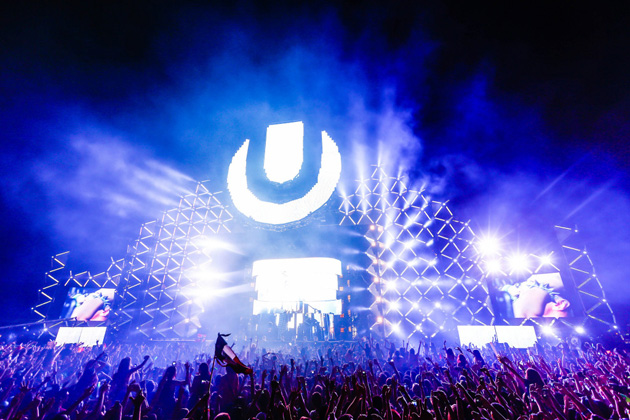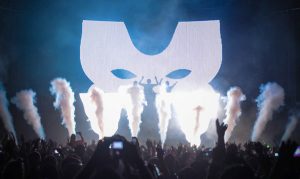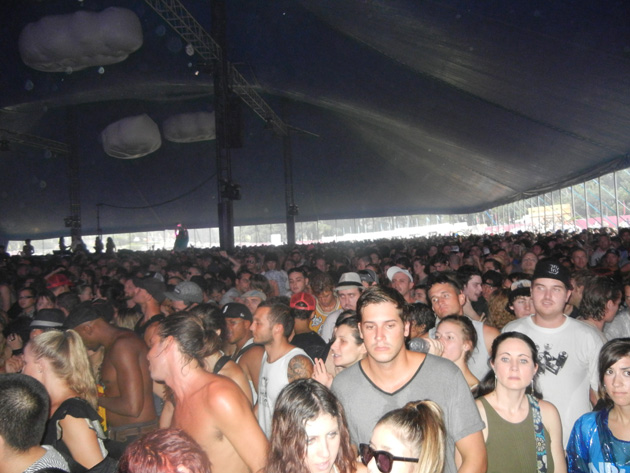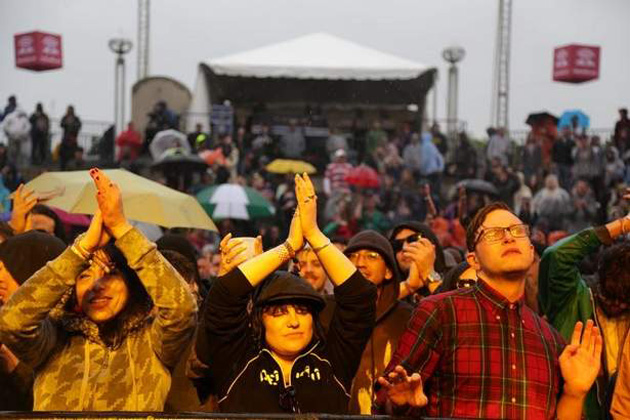 With Ultra Music Festival expanding to two weekends, the 2013 Winter Music Conference’s workshops in between, and plenty of DJ appearances at local clubs over roughly 15 days, the city’s electronic music offerings were consolidated into Miami Music Week back in March. After the panels and workshops, we hit up some of the top parties, and more than a diverse offering of sounds representing the spectrum of EDM, the atmosphere indicated a divide of tastes and demographics.
With Ultra Music Festival expanding to two weekends, the 2013 Winter Music Conference’s workshops in between, and plenty of DJ appearances at local clubs over roughly 15 days, the city’s electronic music offerings were consolidated into Miami Music Week back in March. After the panels and workshops, we hit up some of the top parties, and more than a diverse offering of sounds representing the spectrum of EDM, the atmosphere indicated a divide of tastes and demographics.
Spinnin’ Records’ debut party at Nikki Beach, with Sander Van Doorn headlining and Nervo, Showtek, and Cedric Gervais supporting, should have been called Ultra-lite: Coeds and frat boy types bounced across the sand in loose-fitting, short, neon-colored attire, while each DJ spent his or her 45 minutes running through the hits. Even as the rain formed puddles around the club’s premises, the beats knocked, the glitzy synths sizzled, and the party didn’t stop until Van Doorn went off the stage to sign autographs.
 But two hours later, we ended up at a far smaller venue, The Treehouse, to watch the Detroit Premiere Artists Showcase. DJs from Kevin Saunderson to Seth Troxler spun the vinyl – and, no, this isn’t a figurative phrase – almost entirely without light, save for a lamp illuminating each turntable. Even in the dark, cramped club, the crowd obviously skewed older, and not a neon bikini was in sight. Sets, too, even with DJs on for less than an hour, always offered up something different: something rhythm focused, or a glimmer of a synth line emerging for a brief second.
But two hours later, we ended up at a far smaller venue, The Treehouse, to watch the Detroit Premiere Artists Showcase. DJs from Kevin Saunderson to Seth Troxler spun the vinyl – and, no, this isn’t a figurative phrase – almost entirely without light, save for a lamp illuminating each turntable. Even in the dark, cramped club, the crowd obviously skewed older, and not a neon bikini was in sight. Sets, too, even with DJs on for less than an hour, always offered up something different: something rhythm focused, or a glimmer of a synth line emerging for a brief second.
Even with newer talents like Troxler, who trash-talked modern EDM in a recent Rolling Stone interview, on the bill, the latter event felt timeless. If you took away The Treehouse’s twee rustic décor, the sets could’ve been a warehouse party from 25 years ago – or a night at the Carl Cox tent at Ultra 2013.
But the divergent talents, sets, vibes, and crowds aren’t just a transition from progressive house to techno – it’s a seemingly-uncompromising rift in electronic dance music. The Village Voice, in a recent blog post, observed this at Coachella 2013, which has taken on a greater electronic music presence in recent years, from acts like New Order and Depeche Mode getting top billing to DJ tends like Sahara. This year, the festival added a second DJ tent, Yuma, which focused entirely on old school acts, including Pete Tong and Richie Hawtin. The writer, in talking about the experience, said it “felt like 1995.”
But while Ultra, Miami Music Week, and Coachella segregate electronic artists by decade, others in the industry question if the divide is real – or something just emerging from how electronic music is marketed in the United States.
Is it All Imagined?
In a May 2013 Beatport News interview, Carl Cox – a DJ who has been faithful to his roots while scoring hits over the years – pinpoints the supposed divide on Europe-vs.-U.S. marketing: Genres are viewed individually, and marketed as such, in Europe, while the U.S. positions EDM (really, progressive and electro house and brostep) above everything else. “They deal success in numbers, big festivals, and strong branding, but they sometimes miss the element of quality,” Cox said. “The American market is reduced to this umbrella term of ‘EDM,’ whereas Europe has this huge name for underground quality and so much of it. Most importantly, people still want to hear it.”
On the other hand, while mainstream majority festivals like Ultra and Electric Daisy Carnival often give a nod to the genre’s roots, at least with one tent, Movement – skewing more underground and known for not adding big-name DJs to its lineup – tried the opposite with its Electric Forest Stage in 2013.

According to the Detroit Free Press, “a subtle tension” existed between the old fans who appreciate artists like Derrick May and Saunderson on the main stage and younger ones who became bored with the heavy techno emphasis.
Blame it on the Old Guys
You’d think that after the late ‘90s electronic dance music scene in the U.S. fading out in the early 2000s, the older, more established performers would appreciate the resurgence a decade later. Instead, in early 2013, the Chemical Brothers went after Swedish House Mafia and Sasha said “Most EDM is made by douchebags for douchebags.” Richie Hawtin and Loco Dice, rather than take down modern performers, went on the road with the CNTRL Tour to educate newer fans about the genre’s origins – and ultimately to show college kids, a significant percentage of festival crowds, that electronic music encompasses a far more diverse palette of sounds.

Around the time Hawtin and his crew went on the road, NPR ran a piece about EDM artists looking to go in another direction. While a good deal of the article focused on Skrillex, who admitted to being inspired by the warehouse party scene in Los Angeles and still does club sets, the author made one somewhat controversial assertion – that the older performers are creating this divide out of resentment.
While radio, MTV, and traditional marketing couldn’t sustain the acts that briefly enjoyed mainstream success in the 1990s, the newer acts, even Swedish House Mafia, are free of label and physical distribution restrictions, as social media builds a fan base and lets artists introduce tracks before an official copy comes out on Beatport.
“There was not enough of an underground to provide a scene,
Yuma tent performer Jason Bentley inadvertently confirmed NPR’s observation when talking to the Village Voice. Expressing disappointment with the atmosphere, Bentley stated: “It all of a sudden became a rock show, which became very concerning to me and a lot of people in the scene. The unifying force of the music and the social dynamic of the scene and community were all of the sudden amended by these rock hallmarks. ”
Fluidity
Others argue that all electronic dance music is underground, until an artist hits it big. While, in a sense, this is moderately true, with even Avicii starting out as just another aspiring producer posting on Laidback Luke’s message board and Luke himself beginning a techno DJ before transitioning into a commercial-friendly sound, Hard’s Gary Richard told the Village Voice that mainstream success for DJs is mostly luck – few go out with the intentions to create a hit.
“I used to think the underground thing mattered – it doesn’t,” Richards said. “Now that Skrillex is popular it’s not like he’s decided to make pop songs with Britney Spears. It’s the same with Baauer. He had this massive crazy thing you could never even dream of on the Internet, but it’s not like he made [‘Harlem Shake’] to be rich and famous. He just made a song because he’s Baauer and it just so happened that everyone else gravitated to it.”

While with certain artists, like Skrillex and Baauer, Richards’ assertion is right, how do you explain David Guetta’s last two albums?
As promoters behind Electric Daisy Carnival are now considering adding old school acts to the main stage not just for exposure but also variety, one thinks of the crowd’s possible reaction: When even younger fans at Movement get bored with the emphasis on techno, how will the bros and sorority babes populating Ultra’s or EDC’s main stage handle it when the soaring melodies and synths drop out for some dark, minimalist beats?




